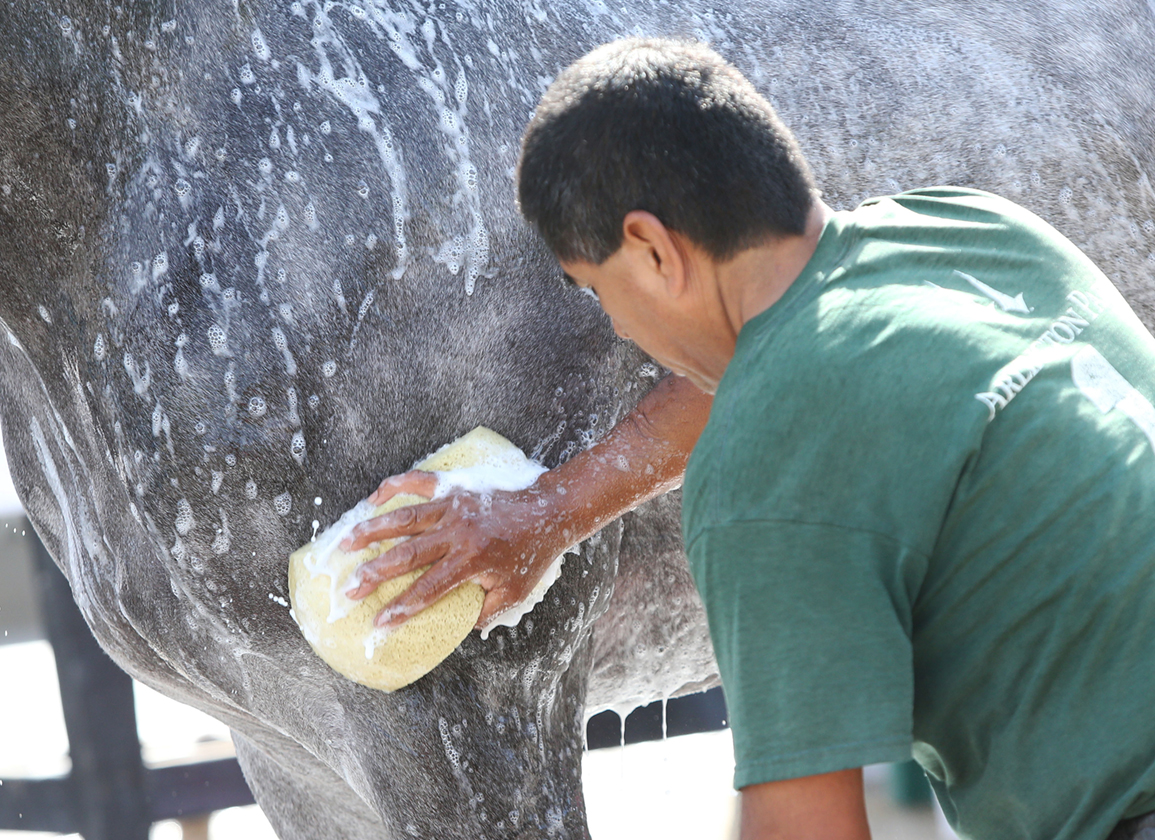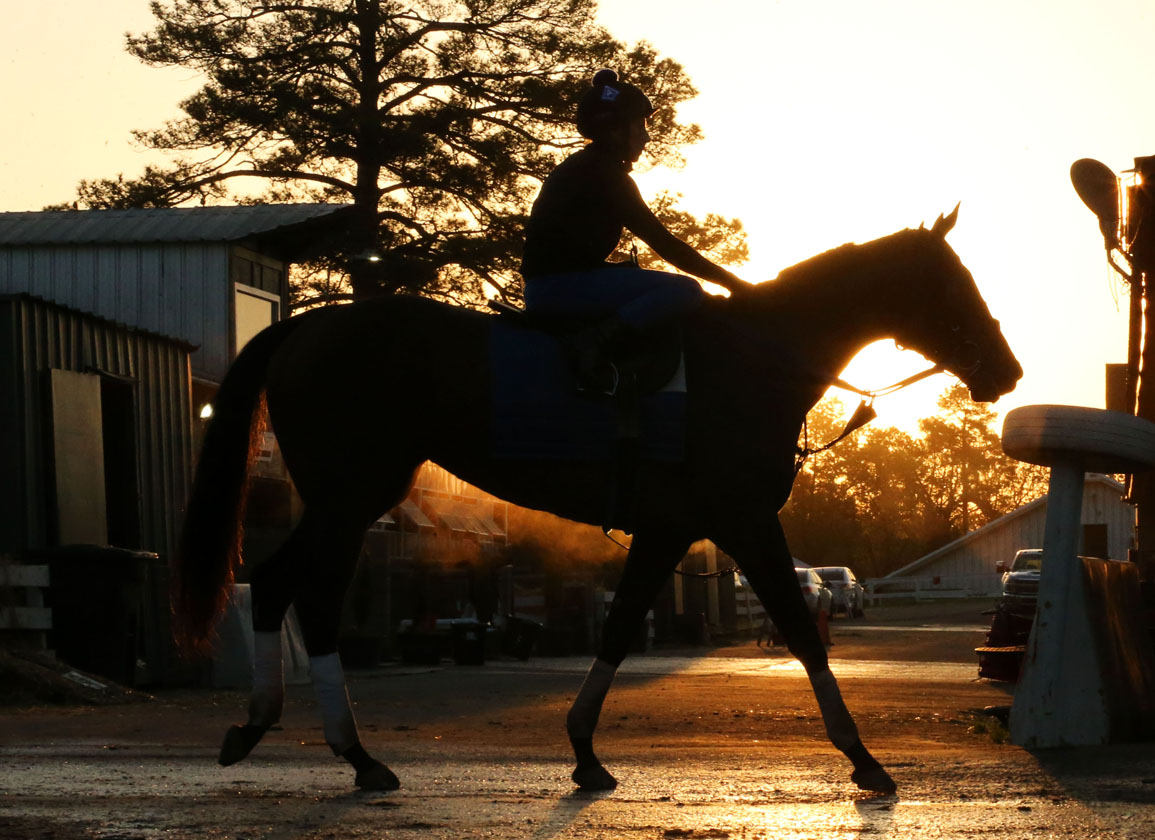By Dan Ross
Last month, the United States Anti-Doping Agency (USADA) announced that in Dr. Tessa Muir, it had plucked from foreign shores a new hire to head its equine program at a time when the agency plays an integral role in implementing the Horseracing Integrity and Safety Act (HISA), overhauling the industry's governing status quo.
Before Muir joined the USADA staff roster, she had hopscotched her way up the industry ladder, from exercise rider to private veterinarian to head of the British Horseracing Authority (BHA)'s anti-doping program between 2013 and 2019. Her last position was as a regulatory veterinarian in Australia, for Racing Victoria.
Currently in the process of earning a master's degree in sports law, Muir faces an even tougher task in bringing to life the enforcement arm of racing's new regulatory framework. That's because there's much to do within a worryingly short amount of time.
Though the official implementation of HISA is set for July 1 next year, a baseline set of uniform rules–medication standards, laboratory testing accreditation rules, and racetrack safety accreditation standards–need to be squared away by the end of the year in order to meet tight administrative deadlines.
What's more, it's still unclear exactly who the enforcement agency will be when the law goes into effect. “No final agreement on USADA's involvement as the enforcement agency is currently in place,” Muir said, in a video presentation for the recent The Jockey Club Round Table Conference.
For her part, Muir tipped her hat during the Round Table to the “enormity of the task” ahead of her, saying that “USADA and myself personally are absolutely committed to our role in the inception of HISA, whether that ultimately sees USADA running the program, or contributing its expertise to the development of harmonizing rules and best practices in anti-doping.”
The Horseracing Integrity and Safety Authority–the broad non-profit umbrella established by the law and commonly referred to as just the “Authority”–is expected to unveil important program specifics at an unspecified date this fall.
To try to elicit some details before then, the TDN this week sat down with Muir. The following has been edited for brevity and clarity.
DR: What's your initial takeaway from these first few weeks on the job?
TM: I actually started with USADA in April, so, I've been working with them for a while. The first month here [in the U.S.] has been a little bit of a whirlwind getting settled into a new country.
I've been really excited and encouraged by the engagement we've had with the people we've spoken to. Of course, we've started working with the Authority and their anti-doping and medication control committee, and then, I spent a week in Saratoga leading up to the Round Table, spending time with their state commission vets and the racetrack vets.
We've had our head down working really hard to deliver on some of the other things we need to. There are some challenges that are not unsurmountable if everyone works together and collaborates.
DR: Okay, so when it comes to HISA, given how we don't yet know who will run the enforcement arm of the law, what can you tell industry stakeholders looking at the ticking clock and worrying about the current lack of available specifics?
TM: As I've alluded to, we've got our heads down working really hard with the Authority to develop a set of rules. As you'll have heard, with what the chairman of the Authority [Charles Scheeler] said, the intention is that they'll be ready for socialization to the industry this fall.
HISA passing is the first component of it. The development of these rules and regulations is the second part. Then [comes] the specifics for USADA, and USADA becoming the enforcement agency.
I think we're all keen to get there ASAP. Of course, the rules go into effect on the first of July next year. But as you and the industry can appreciate, there are a number of things to work through given the expanse of the program for it all to come together.
DR: How well placed is USADA to manage what would appear a significant increase in testing volume, even if it's just in an oversight role? Does it have the necessary personnel?
TM: The intent is not to totally reinvent the wheel. There are good practices in place that can be leveraged. We will look to utilize existing infrastructure–for example, in testing barns where it's possible.
I think something else that comes into the mix is how technology might play a key role in running the program. To some extent, when you look at USADA's team, they've begun to expand the team to administer the program. But certainly, there's going to be a need for people who can leverage the existing structures.
DR: When it comes to HISA's approach to the public reporting of testing, what can we expect? Will there be greater transparency concerning all horses who are tested and not just the positives, for example? How will you approach the reporting of out-of-competition testing?
TM: There's a need for transparency in competition–for race day and in the out-of-competition component. If you look at USADA's history, they've been huge advocates for transparency and for sharing testing data.
If you look on their website, you can search for an individual athlete and see how many times they've been tested in a year or in a quarter, which I think is a really positive thing.
On the equine side, we definitely want to publish testing data. I think there's a balance–you want to publish and be transparent to the point it doesn't compromise the integrity of the independent testing program you've got in place.
DR: Are you able though to talk about what you think may be made public?
TM: It's probably a little too early to delve into specifics. There are things we've discussed with the Authority. If you take USADA's example of what there is with human sports, you can search any individual athlete by name, and you can see how many times they've been tested within that breakdown.
You can also look to other racing jurisdictions where they already publish some of this data, such as in Racing Victoria. After the race day, they publish a report on what horses got tested, pre-race and post-race.
Without saying we've landed on a specific final picture of what it might look like, I think that gives you a nice example of where there are standards already set where we can look and say, 'Where can we expand on that to give the public transparency?'
Note: Click here for USADA's athlete test history database.
Click here for an example of a Racing Victoria post-race day stewards' report.
DR: You said in your Jockey Club Round Table presentation that it'll take a while before USADA's “gold standard” anti-doping infrastructure will be implemented. What kind of timetable are you envisaging?
TM: We've got the first July deadline for next year. We need a program in place that's robust and covers the essentials. One of the big bits are the rules that need to be in place to get that uniformity. Looking forward, maybe it'll take 18 to 24 months to reach that gold standard of our independent program.
You've got to look at developing laboratory standards and their capabilities, the intel and investigations of course take shape over time, and a smart testing program similar to what USADA use in their human world–you've got to develop that data to drive that forward. And again, we'll be looking at technology as one of the key components to finesse that program.
As is the case with the human program, things never stand still. We work hard every single day to continually improve and adjust and refine the program.
DR: You use that 18-month timeframe. On a very practical level, what tangible differences can industry stakeholders expect to see between implementation on July 1 next year and then 18 months from then?
TM: The real tangibles you'll see on day one is the uniformity in the rules and some of those basic interactions and processes.
The development is still to be determined in many ways–as much as we can get in on day one the better. But of course, things like the smart testing program and refining how you select horses for testing, and the things you learn as you collate and collect data, it will of course evolve over that period of time.
Getting all the laboratories to a baseline and then developing that side of it–that's probably not the front-facing side of it, it's probably the development and the refinements behind the scenes.
The labs are really good ones to look at because developing new methodologies, investigative equipment and all that kind of stuff, takes time, and so, we're looking at: What do we need on day one for the program to function as a robust program? And then, how can we look to develop that going forward?
DR: Anti-doping deterrence costs money, and I think it's fair to say the financial component is of central concern to most stakeholders. What specifics can you share about what they can expect when it comes to costs, and specifically anti-doping deterrence and prevention costs?
TM: I think that's slightly two questions. The prevention and deterrence side is multi-factorial. It's not an isolated area. We've got education, out-of-competition no-notice testing, tip lines and investigations.
It's not an expensive cost per-se developing those rules and having those consistent results management arbitration processes–sanctions that deter those bad athletes. That covers deterrence and prevention as a whole.
On the question of the cost, that's probably the number one question that everyone asks. I think one of the challenges at the moment is that there's not any one currently accepted understanding of what the total cost and total amount currently being spent is. So, getting a handle on that is quite difficult to know: How is it going to be more expensive, and by how much?
As the chairman alluded to at the Round Table, he said publicly that they anticipate the costs are going to go up, and of course, that's to be expected for an enhanced and more effective program of the scale we're looking at here.
It's a comparatively small investment–I'm not saying it's necessarily a small amount of money, not to belittle the amount–but a comparatively small investment in protecting the fairness of clean racing for all our horsemen and obviously the health and welfare of the horses and the longevity of the sport in the future.
As far as what the actual dollar amount is, as [Scheeler] said, that's still being worked on at the moment. It's hard not having that really clear-cut number on what's currently being spent. There's money being spent in a lot of different areas currently.
DR: When it comes to the everyday adjudication of medication violations, Jockey Club vice chairman Bill Lear told me recently there'll likely be a tiered approach in the beginning, with the severity of the infraction governing which set of regulatory personnel–either the state's or USADA's–will handle the hearing. Could you elaborate on that?
TM: From a top-level look at it, the results management and adjudication process will come under the banner of the enforcement agency, so assuming that is USADA, USADA will be responsible for any of the anti-doping rule violations that occur.
As [Lear] alluded to, certainly looking at a tiered approach for that. The specifics will be made a lot clearer when the socialization process happens with the industry.
DR: Obviously, a key issue with the current status quo is the glacial pace at which violations are adjudicated. Do you see a scenario whereby that process is expedited come July 1 next year?
TM: The intention is to have a streamlined process, but of course, there is the [matter] of due process, and that's something that is probably better answered by someone [in the] legal [department]. Obviously, we have a legal team at USADA that deals with the human side. The processes and the streamlined nature of that will become more evident when the arbitration procedures and the rules are socialized in the fall.
DR: One of USADA's big selling points is its educational programs for human sports. What will HISA's education outreach look like for racing? And how will you make sure everyone in the sport–irrespective of language barriers–gets access to the necessary information?
TM: You've made a great point that the education component of any anti-doping and medication program is a foundation to the success of the program.
There's a variety of ways to actually deliver that information in an effective way. Something we'll be looking to is a level of education in place ahead of the first of July 2022, because people will need to understand what the new requirements are. And of course, some of that will be developed beyond that.
The point about language is a really good one. That's something we're cognizant of as we look to start developing and creating education materials, ensuring that those people who need to be communicated with, and to engage with the process, can do so.
There are a lot of parties beyond just the trainers and the grooms who touch these horses on a day-to-day basis, and therefore, we want to be in the best position possible to give people the tools to comply with the rules.
DR: Have you started putting these materials together?
TM: Specific materials? No. First of all, before you can design educational materials, we need rules that we can educate people on. And so, at the moment, it's not our number one priority.
But as far as concepts and looking at good ideas–I've certainly done a few of the USADA education tools online to get an idea of some of the things that might be great to leverage.
Read part one and part two of our recent series digging down into the particulars of HISA.
Not a subscriber? Click here to sign up for the daily PDF or alerts.











